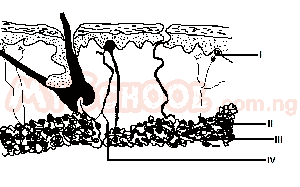
The structure labelled II is known as
- A. sweat gland
- B. lymph vessel
- C. blood vessel
- D. nerve ending

The part labelled III is for
- A. protection
- B. insulation
- C. lubrication
- D. growth
The correct sequence for the perception of smell in mammals is
- A. chemicals → olfactory nerve endings → brain
- B. dissolved chemicals → nasal sensory cell → brain
- C. chemicals → mucus membrane → sensory cells→ brain
- D. dissolved chemicals → sensory cells → olfactory nerve → brain
Bacteria multiply rapidly by means of
- A. budding
- B. fragmentation
- C. binary fission
- D. spore formation
In epigeal germination, the cotyledons are
- A. carried above the ground by the elongation hypocotyl
- B. pulled underground by the elongating epicotyl
- C. pulled underground by the elongating epicotyl
- D. carried above the ground by the elongating epicotyl
Insects visit flowers in order to
- A. feed on the nectar
- B. deposit pollen on the stigma
- C. pollinate the flowers
- D. transfer pollen from anthers
Fertilization in humans usually takes place in the
- A. lower part of the uterus
- B. upper part of the uterus
- C. lower part of the oviduct
- D. upper part of the oviduct
In dissection, the rib cage of mammal has to be opened in order to expose the
- A. diaphragm
- B. liver
- C. heart
- D. sternum
The lymphatic system of mammals rejoins the blood circulatory system at the
- A. hepatic vein
- B. subclavian vein
- C. renal vein
- D. common iliac vein
Yellowing of leaves is a symptom associated with deficiency of
- A. iron, calcium and magnesium
- B. nitrogen, sulphur and potassium
- C. sulphur, phosphorus and iron
- D. magnesium, nitrogen and iron
The force that holds water together in the form of a stream within the xylem tube is the
- A. cohesion of water molecules to one another by hydrogen bonds
- B. force of gravity attacking the water molecules through the hydrogen bonds
- C. attraction between the water and xylem osmotic force
- D. normal flow of water from the ground with help of gravitational force
The richest source of vitamin A are
- A. palm oil and groundnut oil
- B. palm oil and carrot
- C. rice and groundnut oil
- D. oranges and carrot
The modes of nutrition in Nitrobacter, Ascaris and Homo sapiens respectively are
- A. photosynthetic , parasitic and holozoic
- B. chemosynthetic, parasitic and holozoic
- C. photosynthetic, parasitic and heterophytic
- D. chemosynthetic, holophytic and holozoic
Mammals acclimatize to reduced oxygen content at high altitudes by
- A. the stimulation of marrow to reduce the amount of erythrocytes produced
- B. increasing the rate at which erythrocytes are destroyed
- C. the stimulation of marrow to produce more erythrocytes
- D. increasing the break down of the protein portion of the erythrocytes
The dark reaction of photosynthesis involves
- A. fixation of carbon (IV) oxide to give six-carbon sugar
- B. fixation of carbon (IV) oxide with the help of oxygen
- C. use of carbon (IV) oxide to produce glucose using ATP
- D. fixation of carbon (IV) oxide on chlorophyll using hydrogen
After a meal of yam has been digested, the highest concentration of glucose is to be found in the
- A. hepatic artery
- B. pulmonary vein
- C. hepatic portal vein
- D. posterior vena cava
Substance manufactured by the leaves are transported to other parts of the plant through the
- A. phloem
- B. companion cells
- C. sieve tubes
- D. cambium
In the woody stems, gaseous exchange takes place through the
- A. micropyles
- B. stomata
- C. lenticels
- D. vessels
In plant cells, the chloroplast are located
- A. inside the cell wall
- B. outside the protoplasm
- C. within the vacuole
- D. within the cytoplasm
They key event in the transition of the amphibians from water to land is the
- A. replacement of the gills with lungs
- B. possession of webbed limbs
- C. development of long hing limbs
- D. possession of tympanic membrane
In which of the following organisms does each cell combine the function of nutrition, reproduction and growth?
- A. Rhizophus
- B. Dryopteris
- C. Brachymenium
- D. Spirogyra


